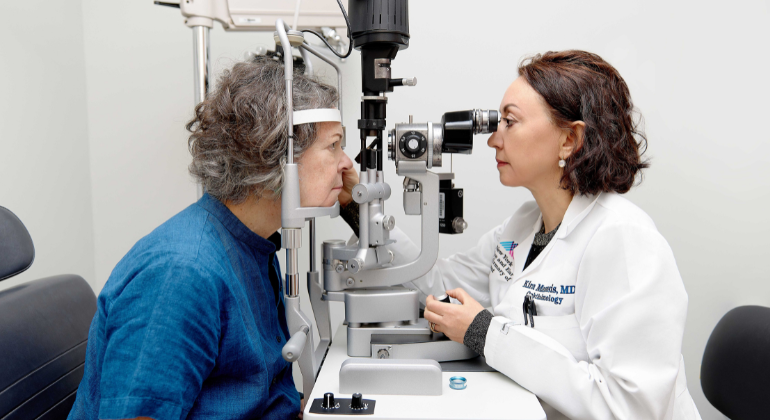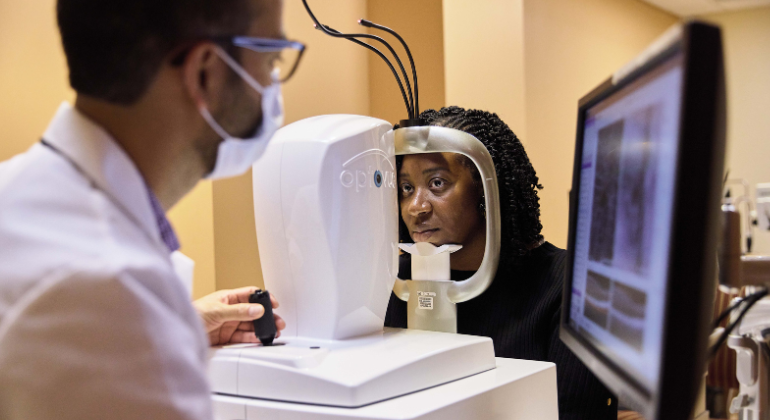January Is Glaucoma Awareness Month
Mount Sinai Doctors Share Tips and Early Detection of the Degenerative Eye Disease
January is Glaucoma Awareness Month,and physicians at the Mount Sinai Health System are sharing their expertise on the disease and its detection, and urging high-risk groups to get comprehensive eye exams.
“While there is currently no cure for the potentially blinding disease, there are available, effective treatments to preserve vision loss if the disease is detected and long-term comprehensive care is delivered,” said James C. Tsai, MD, MBA, Delafield-Rodgers Professor and Chair, Department of Ophthalmology, Mount Sinai Health System; President, New York Eye and Ear Infirmary of Mount Sinai; and Chair, Glaucoma Subcommittee, National Eye Health Education Program. “A comprehensive eye examination with careful evaluation of the optic nerve and/or visual field is required to detect and diagnose glaucoma since the disease can occur even in the setting of normal eye pressures.”
Glaucoma, often referred to as “the thief of sight,” damages the optic nerve when fluid builds up in the front part of the eye, increasing eye pressure. According to the National Eye Institute, glaucoma is a leading cause of vision loss in the United States. Approximately 3 million people over the age of 40 have the disease, and half of those people don’t even know it because glaucoma has no symptoms in the early stages. Peripheral or side vision gradually worsens without the patient’s realization as the disease progresses into later stages. If left undetected and untreated, glaucoma can cause complete blindness.
Facts on Glaucoma
- Vision loss from glaucoma is irreversible.
- An estimated 4 million people will have glaucoma by 2030 and 6 million will have it by 2050 (National Eye Institute).
- Glaucoma can affect everyone from babies to senior citizens.
- People over the age of 45 are at highest risk.
- There are eight types of glaucoma; primary open-angle glaucoma is the most common type.
- African American and Latino populations have a greater tendency to develop primary open-angle glaucoma.
- Glaucoma often runs in families and may be inherited.
- People with diabetes, nearsightedness, regular steroid/cortisone use, and extremely high or low blood pressure are also at risk.
Tips on Detection
- Early diagnosis is key to preventing vision loss.
- People under the age of 40 should have a comprehensive dilated eye exam every 3 to 4 years.
- People under 40 with risk factors should have the eye exam every 1 to 2 years.
- Patients 40 and older should have a comprehensive exam every 1 to 2 years.
- Everyone 40 and older with risk factors should be examined annually.
- Patients 65 and older should have yearly comprehensive exams.
Treatment
- Since vision loss is irreversible, the goal is to get the eye pressure under control.
- Eye Drops
- Laser Surgery
- Eye Operation
Experts Available for Interview
- Paul Sidoti, MD, Deputy Chair for Clinical Affairs, New York Eye and Ear Infirmary of Mount Sinai (NYEE); Professor of Ophthalmology, Icahn School of Medicine at Mount Sinai
- Robert Ritch, MD, Shelley and Steven Einhorn Distinguished Chair in Ophthalmology, Surgeon Director Emeritus, Chief of Glaucoma Services, NYEE
- Joseph Panarelli, MD, Glaucoma Fellowship Director, Associate Residency Program Director, NYEE; Assistant Professor of Ophthalmology, Icahn School of Medicine at Mount Sinai
- Tania Tai, MD, Co-Director of the Glaucoma Clinic, NYEE; Assistant Professor of Ophthalmology, Icahn School of Medicine at Mount Sinai
Mount Sinai’s Recent Glaucoma Research
- Breakthrough research out of the Icahn School of Medicine at Mount Sinai is describing the basic cellular mechanisms of exfoliation glaucoma for the first time. The study, published in the July 2016 issue of PLOS 1, identifies the first cellular model of exfoliation glaucoma, which could lead to a possible cure, and drugs for treatment. With the study’s findings, researchers can use certain cells as a model system to study the mechanisms of the disease to find a cure for exfoliation glaucoma. Additionally, researchers can use the cells to screen drugs that might reverse the condition.
Read the study: http://journals.plos.org/plosone/article?id=10.1371%2Fjournal.pone.0157404
- Groundbreaking research involving NYEE shows a possible link between women with exfoliation syndrome (XFS) and pelvic organ prolapse. The study, published in the September 15, 2016, issue of JAMA Ophthalmology, is the first time a connection has been made between XFS and an elastic tissue disease. It shows that women who have pelvic organ prolapse (POP) are at risk for developing exfoliation syndrome, an inherited systemic disorder that often leads to a severe form of glaucoma. The findings could lead women with POP to get early screening for exfoliation syndrome, and potentially save their vision.
Read the study: http://archopht.jamanetwork.com/article.aspx?articleid=2552687
- In a first-of-its-kind study, Mount Sinai researchers are using optimal coherence tomography (OCT) angiography to look at the earliest stages of glaucoma and identify characteristic patterns of different forms of glaucoma based on their vascular patterns. The findings were published in the October 14, 2016, issue of IOVS. Using this technology, a team of scientists from NYEE and the Icahn School of Medicine at Mount Sinai have discovered that all glaucoma patients have fewer blood vessels, or less blood flow to the eyes, compared to patients without glaucoma. The findings could lead doctors to diagnose glaucoma cases earlier than ever before and potentially slow down the progression of vision loss.
Read the study: http://iovs.arvojournals.org/article.aspx?articleid=2570243
Patient Story
Our patient is 7-month-old Meagan Charles of Brooklyn, New York. The story highlights the need for all age groups to have complete eye exams and take quick action to avoid vision loss from glaucoma.
When Meagan was a month old, her mother, Sebrina Cordoza, started noticing her badly squinting in the sun, and rubbing her eyes. She thought it was allergies, until she noticed the infant was in pain. After seeing several specialists, she found out Meagan had pediatric glaucoma, and was in danger of losing her eyesight. At 3 months old, Meagan ended up at NYEE, where Dr. Joseph Panarelli did emergency surgery on her right eye, and then her left eye the following week. Dr. Panarelli performed a 360 trabeculotomy, with the iScience catheter, a treatment performed in only a few eye centers across the country. This is a new, more effective spin on an existing procedure that has revolutionized the treatment of pediatric glaucoma. The surgeon uses an illuminated, flexible microcatheter, which has a larger diameter compared to previous instruments used in these surgeries. The illumination helps to avoid potential complications resulting from misdirection of the catheter.
After the procedure, Meagan is doing great. There were no complications and her prognosis is excellent, her vision is now good, and Dr. Panarelli is monitoring her to see if she needs glasses. “This is the best possible outcome we could have hoped for, and her case highlights the need for parents to be diligent if they notice their children having eye issues,” Dr. Panarelli explained.
“We couldn’t be more ecstatic that Meagan can see again and that she is now living pain-free thanks to the work of Dr. Panarelli,” Ms. Cordoza said. Both Ms. Cordoza and Dr. Panarelli are willing to be interviewed. We also have video of the procedure, along with before/after pictures of Meagan to share.
Please let us know if you are interested in pursuing the patient story or speaking with any of our glaucoma experts.
About the Mount Sinai Health System
Mount Sinai Health System is one of the largest academic medical systems in the New York metro area, with 48,000 employees working across seven hospitals, more than 400 outpatient practices, more than 600 research and clinical labs, a school of nursing, and a leading school of medicine and graduate education. Mount Sinai advances health for all people, everywhere, by taking on the most complex health care challenges of our time—discovering and applying new scientific learning and knowledge; developing safer, more effective treatments; educating the next generation of medical leaders and innovators; and supporting local communities by delivering high-quality care to all who need it.
Through the integration of its hospitals, labs, and schools, Mount Sinai offers comprehensive health care solutions from birth through geriatrics, leveraging innovative approaches such as artificial intelligence and informatics while keeping patients’ medical and emotional needs at the center of all treatment. The Health System includes approximately 9,000 primary and specialty care physicians and 10 free-standing joint-venture centers throughout the five boroughs of New York City, Westchester, Long Island, and Florida. Hospitals within the System are consistently ranked by Newsweek’s® “The World’s Best Smart Hospitals, Best in State Hospitals, World Best Hospitals and Best Specialty Hospitals” and by U.S. News & World Report's® “Best Hospitals” and “Best Children’s Hospitals.” The Mount Sinai Hospital is on the U.S. News & World Report® “Best Hospitals” Honor Roll for 2025-2026.
For more information, visit https://www.mountsinai.org or find Mount Sinai on Facebook, Instagram, LinkedIn, X, and YouTube.
Mount Sinai Recruits Internationally Recognized Ophthalmologists to Expand Leadership
Dec 17, 2018 View All Press ReleasesMount Sinai Establishes the Eye and Vision Research Institute
Jan 09, 2017 View All Press Releases


